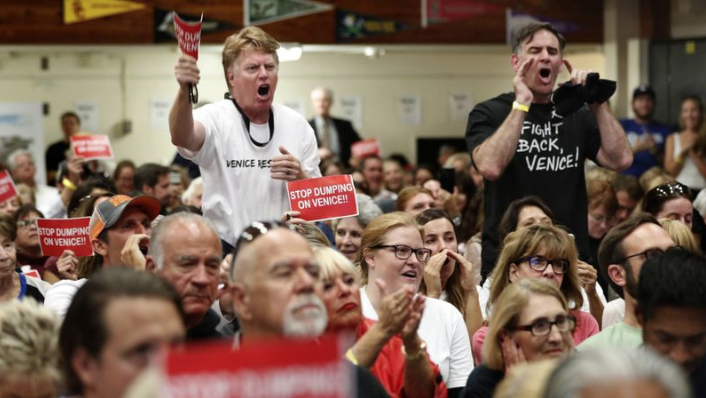CommentsDEEGAN ON LA-It’s a new year, but there seems to be some old behavior carrying over. Empowered by many successes against what they see as predatory developers, “NIMBY’s” (not in my backyard) have identified a new target: shelters for the homeless in their neighborhoods.
As the City tries to distribute funding for shelters and supportive housing for the homeless into each of the 15 council districts, some communities are pushing back and out. One, Venice, has even threatened to sue.
Five of the fifteen Council Districts now have active plans in the works to support the Mayor’s “bridge housing” program. But many more communities, led by their City Councilmembers, still need to activate “bridge housing” in their districts. The prospect of resistance and “NIMBYism” still remains high.
However, there are already some success stories for Mayor Garcetti’s A Bridge Home program, which he says “puts Angelenos on a path out of homelessness and into supportive housing.”
About one third of the council districts are engaged with the Mayor’s plan to use up to $2 million per district to construct emergency bridge housing that is part of his plan.
While the results look promising, the program has had its issues with community activists who are saying, “Not In My Back Yard.” A few examples of this is what happened in Koreatown, Venice, and Sherman Oaks.
In K’town, city politicos at the top of the food chain, Mayor Garcetti and Council President Herb Wesson (CD10), were embarrassed by the strenuous objections of the community to place “bridge housing” at a city-owned property located near the Wilshire/Vermont subway station. It’s as if they cooked up their plan without checking in with those in the community who were needed to support their ambitions. They sent out the junior varsity bench to carry out the project.
Wesson and Garcetti have assessed the public blowback and are engaging in outreach and are studying alternative sites. Unfortunately, these two seasoned politicos appeared to be out of touch with their constituents and community, but now they are mollifying the situation by asking the community for buy in.
When engaged early on, potential NIMBYs can become supporters of housing the homeless. This was demonstrated in Sherman Oaks where NIMBYs at first called for the Councilmember’s recall for suggesting that homeless people be sheltered in their community. Working with community leadership groups like the Sherman Oaks Neighborhood Council and the Sherman Oaks Homeowners Association, however, CD 4’s Councilmember David Ryu offered a plan for bridge housing in their community and gained some support. Final decisions are still to be determined for this work in progress.
In Venice, Mark Ryavec, president of the Venice Stakeholders Association, has threatened to sue the City, saying it had not completely addressed concerns about noise and parking, two issues not generally known as problems in housing the homelessness.
Councilmember Mike Bonin (CD11) supports a 154-bed homeless shelter that will house 100 adults and 54 younger people, ages 18-24, on Sunset Avenue at an unused Metropolitan Transportation Authority yard. The shelter would be a modular tent structure holding 100 beds, while youths would be housed in nine trailers. The project will also have trailers for hygiene and administrative work, storage units, a pet area, and outdoor dining space.
Hooray for Hollywood and downtown Los Angeles. Both areas look like model success stories.
In DTLA (Jose Huizar, CD14) the City opened the first shelter housing that is part of A Bridge Home in the El Pueblo historic district. It will shelter 45 homeless people who are provided a bed, bathrooms, showers, laundry facilities and storage facilities. The facilities will be open around the clock, unlike traditional homeless shelters that have specified times for occupancy. Social services will be offered by staff who come on-site to provide health services and case management. It’s being showcased by the Mayor as model of what other A Bridge Home shelters can become.
Given that it’s in Hollywood, it’s no surprise that the bridge housing shelter planned in Mitch O’Farrell’s (CD13) district has some glamour attached to it. The former Hollywood Studio Club at the intersection of Lodi Place and Lexington Avenue, owned by the YWCA, is a landmarked Mediterranean-style building that was designed and constructed in 1926 by Hearst Castle architect Julia Morgan as a residence for women with careers in the movie business. It’s now being repurposed for homeless women who are struggling to survive on the streets of Hollywood. Sixty-four beds will be located on the third floor. When the “Y” eventually moves, space for an additional 62 beds will open up.
So, the Mayor along with a handful of City Councilmembers and the homeless now have some hope that a plan is moving into place with room to grow. Especially as Measure H and HHH bond revenue, which has been earmarked for affordable housing, flows into the City’s treasury.
How the “bridge housing” program rolls out will be equally up to the politicos and the communities affected. Hopefully, many more neighborhoods will reject the moniker of NIMBY and say, “Yes in My Back Yard.”
(Tim Deegan is a civic activist whose DEEGAN ON LA weekly column about city planning, new urbanism, the environment, and the homeless appear in CityWatch. Tim can be reached at [email protected].) Edited for CityWatch by Linda Abrams.
















